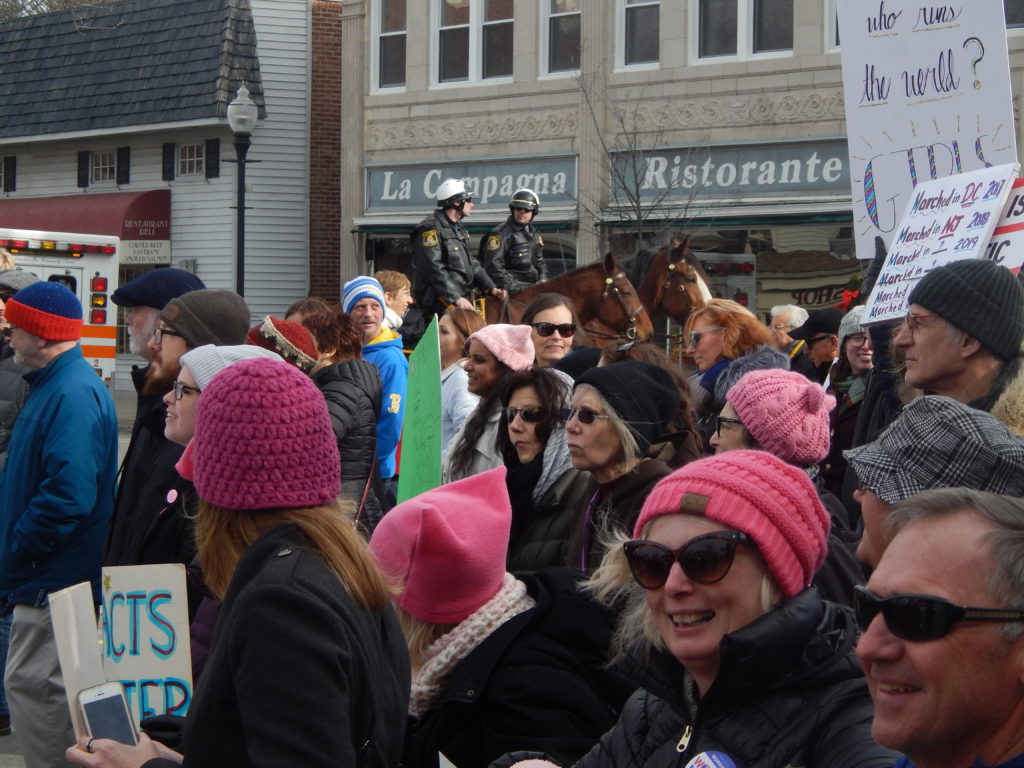An Anti-Trump Political Movement in Search of a Name as Catchy as ‘Tea Party’

Are we seeing a Democratic version of the Tea Party?
Perhaps.
That thought crossed my mind last weekend as I covered the Women’s March in Morristown and read about similar marches all over the country.
I came across one quote in particular from a Bergen County woman who attended the march in Manhattan. She said that until the election of Donald Trump as president, she and her circle of friends spent much of their TV time watching “reality shows.” Now, they watch news programs, or if you prefer, “real reality shows.”
This is important for politics now and going forward.
Follow politics for a while and you quickly realize that a key to winning elections is not convincing those who disagree with you to come over to your side. That’s unlikely to happen, especially in these very polarizing times.
The key is to somehow get those who agree with you to actually vote.
This is critical at a time when voter turnout is considered good if it reaches 50 percent. The more “non-voters” you can energize, the better it is for you.
Let’s go back to 2009 and 2010.
It was the election of Barack Obama that fueled much discontent on the right. There were a variety of issues – simple racism among them – but a main rallying point was opposition to health care reform or “Obamacare.”
Many people in the original Tea Party movement were not politically-astute at all. They didn’t really understand the complexity of many issues. Some probably did not even consider themselves “conservatives,” or “Republican.”
Buy they knew what they were against – Barack Obama.. And over time, this grassroots uprising on the right fueled a big Republican win in the 2010 midterm election and many victories on the state and local level.
Now let’s move to Trump’s election in 2016.
It so galvanized opponents that the original women’s marches on Jan. 21, 2017 – the day after Trump’s inauguration – were a resounding success. And they prompted many observers to wonder where all that excitement was in November of 2016.
Viewing this year’s Morristown march and listening to the speakers, it seemed clear that there was no overriding philosophy. This was not, for example, an anti-war protest where demonstrators were squarely-focused on one issue.
Instead, judging from the signs and speakers, just about every left-wing cause was being espoused, and even some problematic, or controversial, ones. One speaker, in fact, talked about the need for Palestine “to be free.”
That comment seemed to be ignored by the crowd, some of whom likely had no idea what it even meant. While a street march is hardly the forum for a foreign policy debate, the remark about Palestine exemplified the array of issues on people’s mind.
The thread holding everything together, of course, was strident opposition to Trump.
This in general terms is great for Democrats. People driven to think politically for the first time because they abhor Trump are not going to vote Republican.
The recent past offers some guidance.
I will ignore New Jersey where a big Democratic win last November was not unexpected. But it’s a bit harder for anyone to ignore Virginia where Democrats won the governorship and turned around 15 seats in the lower house of the Legislature. Considering the gerrymandering that takes place everywhere, winning that many seats is a monumental achievement.
And then there was Alabama where a Democratic win no matter the circumstances is a huge upset and most recently, Wisconsin, where a Democrat won a special state Senate election in a district Trump carried by double-digits in 2016. The next test comes in March when there is a special congressional election in what is usually a safe Republican district in western Pennsylvania.
It’s never easy to truly know why people vote the way they do. But it’s not a stretch to attribute the Democrats’ recent success to getting new voters to the polls. In Alabama, in fact, many have
written how black turnout was much higher than normal for a special election.
In New Jersey, the normally very Republican 7th and 11th congressional districts are now considered toss-ups.
Why?
The guess here is because so many heretofore apathetic voters are apathetic no more. Months before the June primary and almost a year before the general election, Democratic congressional debates and forums were drawing uncommonly large crowds. This is the type of enthusiasm that can win elections. These individuals and the groups they have created – N.J. 11th for Change is one example – did not exist a few years ago.
Such a new wave of voters is good news for Democrats.
We may be getting a little ahead of ourselves, but there is a potential downside here as well.
It often has been the GOP’s Tea Party contingent in Congress that refuses traditional compromise and makes governing all but impossible.
It was such stridency that forced House Speaker John Boehner to retire in frustration.
We already have seen signs how the Democrats’ growing base of anti-Trump sentiment is impacting the party with the government shutdown, which mercifully seems about to end. It is hard to see Democrats in the Senate supporting a shutdown if their newly-vocal base was not pulling them that way.
Clear-thinking Democrats probably know the inevitable risk that may loom ahead, but as of now, no one is going to complain; there are new votes out there to be had.
And who cares if the left-wing version of the Tea Party lacks a catchy name.











I sure hope that the GOP will awaken their base and unify with a message of prudent spending and smaller government. It appears that as you stated above, the Democrats are espousing every issue imaginable and their only beef is President Trump. Time to stop the onslaught of this progressive movement towards government control of our lives. Remember the Constitution “limits our Governance”.